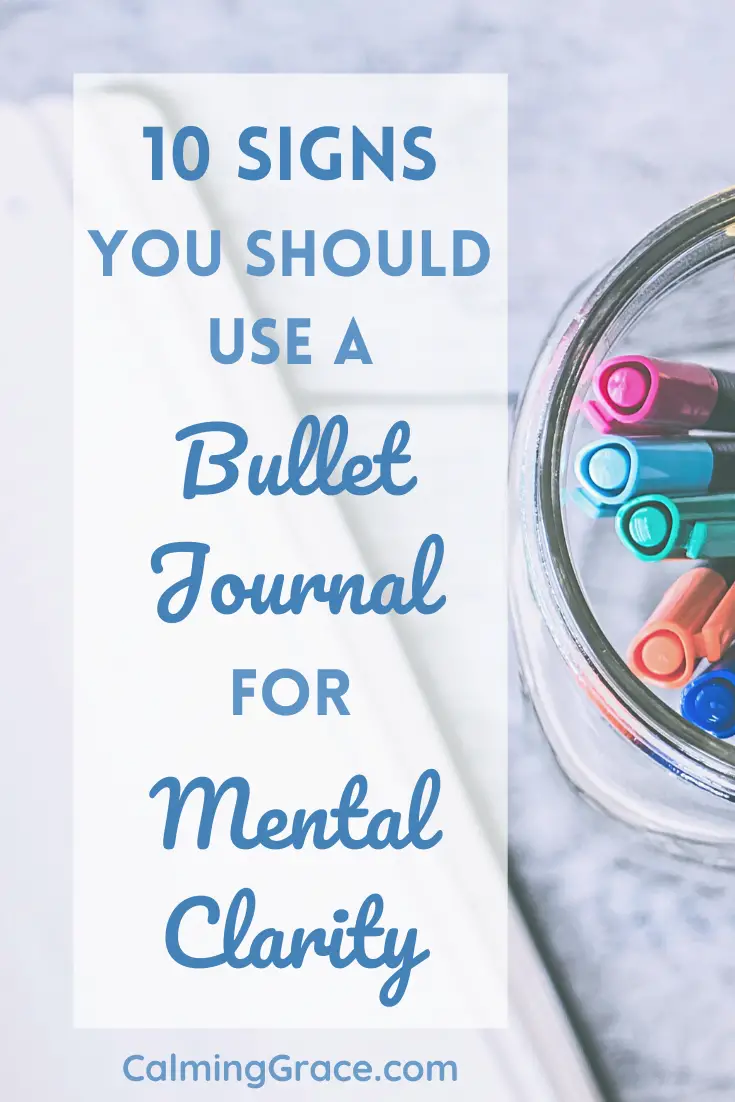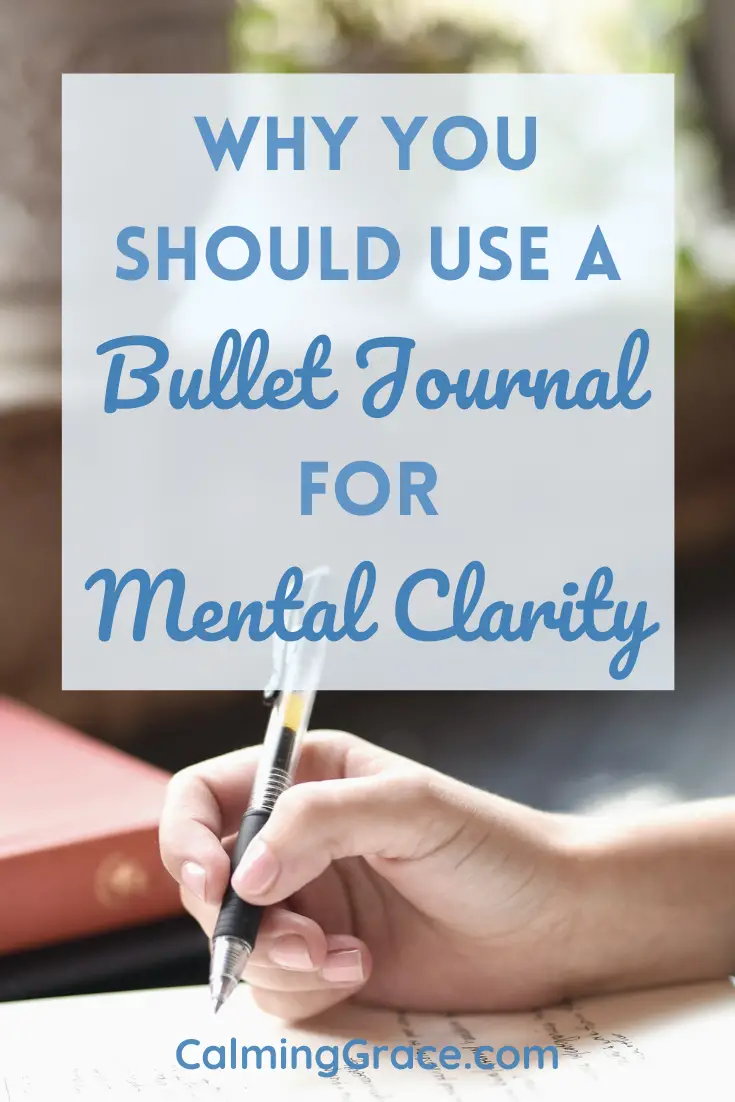Last Updated: August 29, 2024
Do you ever feel like your brain is in a fog? You have so many thoughts, things to do, and things to remember, that you find it difficult to focus? When a lot of thoughts are distracting you, it’s so important to find a way to clear and calm your mind. Journaling is one of the best things you can do when you need to find some mental clarity.
Mental clarity means that your mind is calm and focused. Bullet Journaling is a very effective way to achieve this. Bullet Journaling is a system that promotes mindful, intentional living. In the words of Ryder Carroll, creator of the Bullet Journal Method, it’s a way to “Track the Past, Order the Present, and Design the Future.”
The Bullet Journal method enables you to discover what’s really worth your time and energy. This helps you get clear on your goals and priorities, so you can put things into perspective and focus on the task at hand.
If you’re ready to jump in to using a Bullet Journal for mental clarity, I’ll show you exactly how to do that in my free 5-day email course:
Not sure yet? Are you someone who should use a Bullet Journal for mental clarity? Take a look at these 10 signs that Bullet Journaling is right for you.
This article contains affiliate links. As an Amazon Associate I earn from qualifying purchases. If you buy something using the links, I may earn a commission at no extra cost to you. Read the full affiliate disclosure.
You should use a Bullet Journal for mental clarity if…
1. You feel overwhelmed by all the things you need to do
It’s easy to feel stressed when you think about all the tasks you need to complete. Sometimes, writing it all down can make you feel even more overwhelmed! You just see a daunting list of unfinished things, and you don’t know where to start.
But the Bullet Journal method helps you identify your priorities and know exactly which task to tackle first.
I don’t know about you, but I’ve been known to expect more from myself than is physically possible in a day. Okay, today I’m going to do laundry, call 3 potential florists for my wedding, write my lesson plans, teach my classes, go grocery shopping, AND cook a healthy dinner! (Maybe, if you’re a superhero, all of that is physically possible for you, but regular old me… well, let’s just say the semester before my wedding was pretty stressful!)
Using a Bullet Journal will help you to visualize your tasks and identify exactly what you need to do now, and what can wait till later. It will also help you plan ahead so you’re not caught by surprise by a last-minute deadline!
2. Your mind feels busy and cluttered
We often have dozens of thoughts running through our minds and racing back and forth. If we don’t find a way to manage our thoughts, they take up precious mental energy and prevent us from focusing on any one thing.
When your mind is cluttered, you keep thinking even when you’re working on something. I know I’m not the only one who has read a whole page of a book without knowing what it said! Our minds are somewhere else entirely.
Here’s a trick I’ve found that works. When you notice your mind getting distracted by a thought, stop whatever you’re doing and write that thought down! If you don’t put the thought somewhere, it will keep running in the background and coming back to bother you. But if you write it down, you’re filing it away somewhere else for now. You can come back to it later. This clears up processing power in your mind so you can focus on the present task.
With a Bullet Journal, it’s easier than ever to quickly jot down a thought. Using Rapid Logging and the Task, Note, and Event bullets, you can quickly record whatever’s on your mind and go back to it later.
Best Notebooks Designed for Bullet Journaling
3. You don’t know where all of your time goes
Have you ever gone through a day and wondered, What did I even do today? You were busy all day, but you don’t really know where the time went.
The thing is, if you don’t start mindfully paying attention to how you spend your time, you’ll never be able to change how you spend it. You need to be aware of your habits in order to be able to change them.
To become aware of how you’re spending your time, you can track it in your Bullet Journal. There are several time tracking methods to help you start to understand your own habits.
For example, in 2018 I did time tracking for 4 weeks by creating a schedule in my BuJo for each week. I simply wrote down what I was doing during each hour of the day:
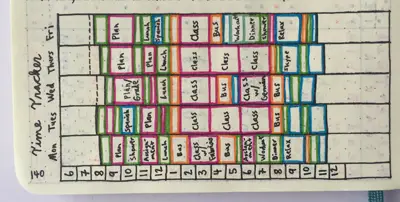
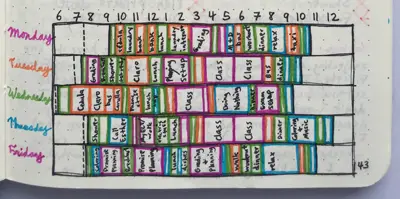
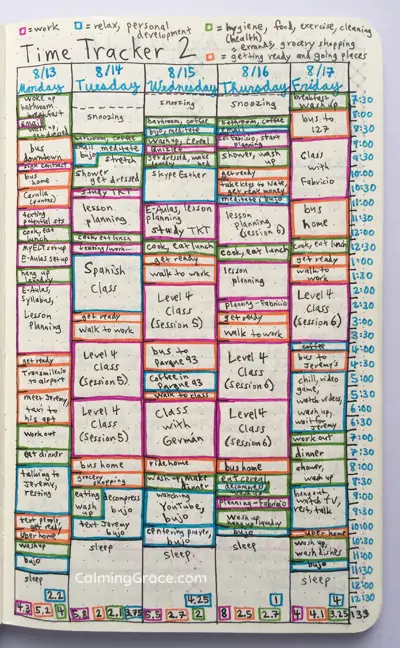
Through this discipline I was able to see how much time I was spending on each color-coded category: work, food/hygiene, errands/transport, and self-care/personal development. Then, I used that “data” to create my own ideal weekly schedule.
Here are some more ideas for using time trackers in your BuJo:
4. You want to build healthy habits, like working out, eating better, or meditating
Are you someone who makes New Year Resolutions, or even mid-year resolutions, but doesn’t keep them? Sorry to break it to you, but you probably won’t act on those resolutions without some kind of accountability! If you want to keep yourself accountable, you need a system.
That’s why one of my favorite features of Bullet Journaling is Habit Tracking. Habit Trackers are usually one page for each month in which you keep track of the healthy habits you keep each day. You can choose the habits you track, but they are usually things like exercising, avoiding sugary foods, drinking enough water, meditating or praying, etc.
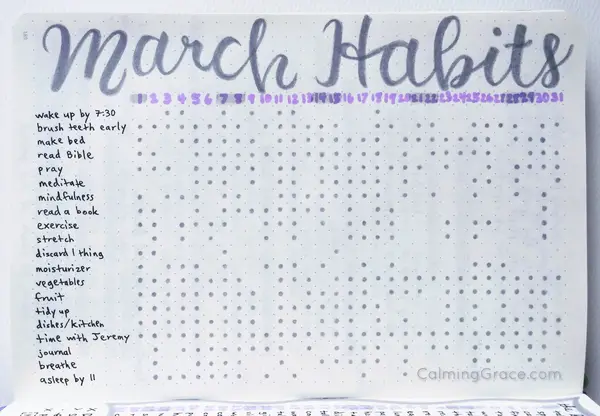
There are a lot of possible Habit Tracker designs, but my go-to is the table format as seen in the photo above. Use one page horizontally. Write the habits you want to track on the side of the page, with the days of the month written across the top. Then, each day, put an “x” or a dot next to the habits you kept that day. With this format, it’s easy to look back at the end of each month and see which habits you’ve mastered and which ones you need to work on.
5. You don’t know how you’re going to reach your goals for the future
Do you have goals and dreams, like write a book, run a marathon, or buy a house? If your goal feels unattainable, like a distant pipe dream for the future, you need to decide if it’s real to you.
If you reach it, is it going to make you a better person? Is it going to make the world a better place? If so, then you need to make your dream more concrete by planning the steps that are going to take you there. A big, daunting goal is impossible to tackle unless you break it down into smaller steps.
Using a Bullet Journal can help you do this. Brainstorm the steps, and write them out in a list in your Bullet Journal. After you break the goal into small, manageable steps, you can then schedule those tasks into your months, weeks, and days.
For example, if you really want to learn Spanish, it’s not going to happen if you just dream about it. You need steps to follow. What apps, videos, or books are you going to use to start learning the basics? Will you take a course? Are you going to study abroad in Colombia to immerse yourself in the language and culture? (Yes, I live in Bogotá so I may be a bit biased, but they say that Colombia is the best place to learn Latin American Spanish 😉 )
The point is, a goal without a step-by-step plan is no more than a dream. The Future Log page in the Bullet Journal method is a powerful tool to help you create, schedule, and follow that plan. In my free 5-day email course, I’ll teach you exactly how to use your Future Log for this purpose:
6. You spend too much time looking at screens
If you spend a lot of time working on a computer, you’re probably aware of the effect of all that screen time on your health. The eye strain… the headaches… the lack of physical activity.
Well, here’s some good news: a lot of the things you use your computer or phone for can also be done using a Bullet Journal. Ryder Carroll calls it “the analog method for the digital age” (Source).
You know how you sometimes turn on your phone just to make a note or put something on your calendar? The Bullet Journal serves the same function, with the added benefit of not having to look at yet another screen. And as long as you write in short form using Rapid Logging, it won’t take you any longer to write it in your journal than to type it on your phone.
Even some of the things you use spreadsheets to track can also be tracked using simple Collections in your BuJo, such as checklists, budgets, and projects. The possibilities are endless.
7. You have a lot of little pieces of paper and post-it notes lying around
Okay, so I have a friend who posted on Facebook about keeping her to-do list on post-it notes on her desk, and it made me cringe a little bit (sorry friend)! She would write her tasks on sticky notes, stick them to her desk, and then throw them away when she finished the tasks.
Maybe it works for some people. But the problem I see with it is that there’s no way to track your progress. You can’t look back and see what you’ve already done. Or, if you write a shopping list or any other list on a piece of paper, you have to keep track of that little paper so you don’t lose it. Then, if you throw it away when it’s done, you don’t have anything to refer back to.
The Bullet Journal solves these problems by putting everything into one place. You can flip through a few pages and visualize what’s been completed. This contributes to mental clarity because you can see what you’ve already worked on, and what you still need to focus on.
Also, it doesn’t take up much space to write these things in your journal: each item or task takes up just one line in the journal, and when it’s done, it simply gets a little “x” marked next to it. Learn more about task status indicators in this article: What are the “bullets” in a Bullet Journal?
My Favorite Supplies for Adding Color to my BuJo Pages
8. You use multiple apps on your phone to keep track of things
I know you do it. You use a notes app to jot down a quick idea. You use a calendar app to see what you’re doing tomorrow. And you use Google Tasks or Evernote or Todoist or one of those I don’t know how many to-do list apps out there, to track your tasks. And maybe you use yet another app to track your sleep, exercise, or diet.
Besides the fact that all of these apps add screen time to your day (as I mentioned in Sign #6), they also force you to switch back and forth between multiple apps on your phone. This doesn’t help with mental clarity. It makes it hard to pay attention to just one thing at a time, gives you the illusion of multitasking, and makes it easier for you to get distracted with all the shiny objects on your phone (oh sure, I can spare a minute to check Instagram…).
Well, guess what? The Bullet Journal method is designed for keeping all of those things in one place, and for being minimally distracting. You can see everything that’s relevant to today on one page in your journal: the Daily Log, which shows you the tasks and events for your day, and gives you space to take notes.
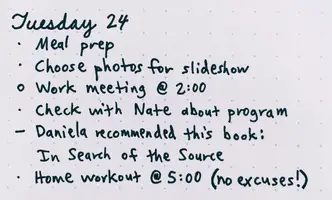
Learn more about the Daily Log and the other essential Bullet Journal pages in this article: How To Start A Bullet Journal, Step By Step: Complete Setup Guide
9. You want to start a journal but think you aren’t artistic enough
If you look at Bullet Journals on Instagram, you’ll see thousands of beautifully elaborate, artistic journal pages. But here’s the thing: the Bullet Journal was designed simply to encourage mindful, intentional living. It was never reserved only for artists.
Some people are naturally artistic and like using their Bullet Journal as a means of self-expression, and that’s fine. It’s what works for them. But what’s great about the Bullet Journal system is that you can use it however it works for you.
Let me tell you: When I started my first BuJo in July of 2017, it was plain and boring. I used whatever pen I could find and didn’t care about my handwriting. But you know what? It accomplished its purpose: to help me clear my mind, and most importantly, feel less stressed.
Just to bring this point into focus a bit more, here are some photos of my first BuJo:
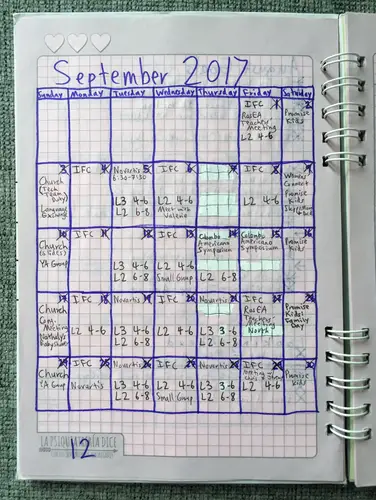
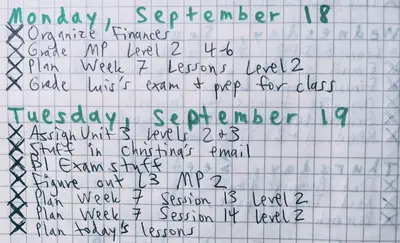
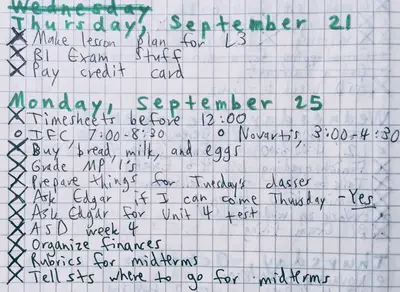
It wasn’t artistic in any way whatsoever. I didn’t even have the “right” kind of notebook. But it was an incredibly valuable tool for bringing focus and clarity to my life in the present moment.
Bullet Journaling really doesn’t need to be complicated. It can be as simple as you want it to be. You can write in chicken scratch and nobody will care. Your BuJo is yours, and you’re using it in the way that works for you.
10. You simply want to figure out your priorities and what’s really worth your time
We get bombarded with things to do every day. From tasks at work to chores at home, and from running errands to relaxing with family, there are so many different ways we can spend our time every day. How, then, do we get clarity on what’s actually important?
The Bullet Journal method is designed to help you resolve this question, over time and through trial and error. When you write your tasks in your BuJo, you can simply look back and see the tasks that you didn’t complete. For whatever reason, it wasn’t urgent enough for you to finish.
Or, if you keep having to re-write a task day after day, that shows you the task is important, but for some reason you’re not getting around to doing it (procrastinating much?).
That’s what the bullet system is for. The process of scheduling, migrating, and completing tasks shows you which tasks are actually worth your time, and which tasks you can set aside for now and decide to do upon later review.
How to Use a Bullet Journal for Mental Clarity
My guess is that you answered YES to at least one of these 10 signs! Anyone can use a Bullet Journal for mental clarity.
So, how do we make this system work for us? It’s simply a matter of setting up your Bullet Journal for success, and then, being consistent and trusting the system.
I’ll show you exactly how to do this in my free 5-day email course. You’ll learn how to use a Bullet Journal to clear and calm your mind, including:
- The single most important exercise you can do in your journal to clear your mind
- The most under-estimated, but the most powerful, page in the Bullet Journal method for organizing your thoughts, ideas, and plans
- How to identify your priorities and long-term goals and make real plans to work towards them
- How to use your journal to improve your overall mental and emotional wellness
Ready? Let’s jump in!
P.S. Did you enjoy this post? Why not save it to Pinterest!

